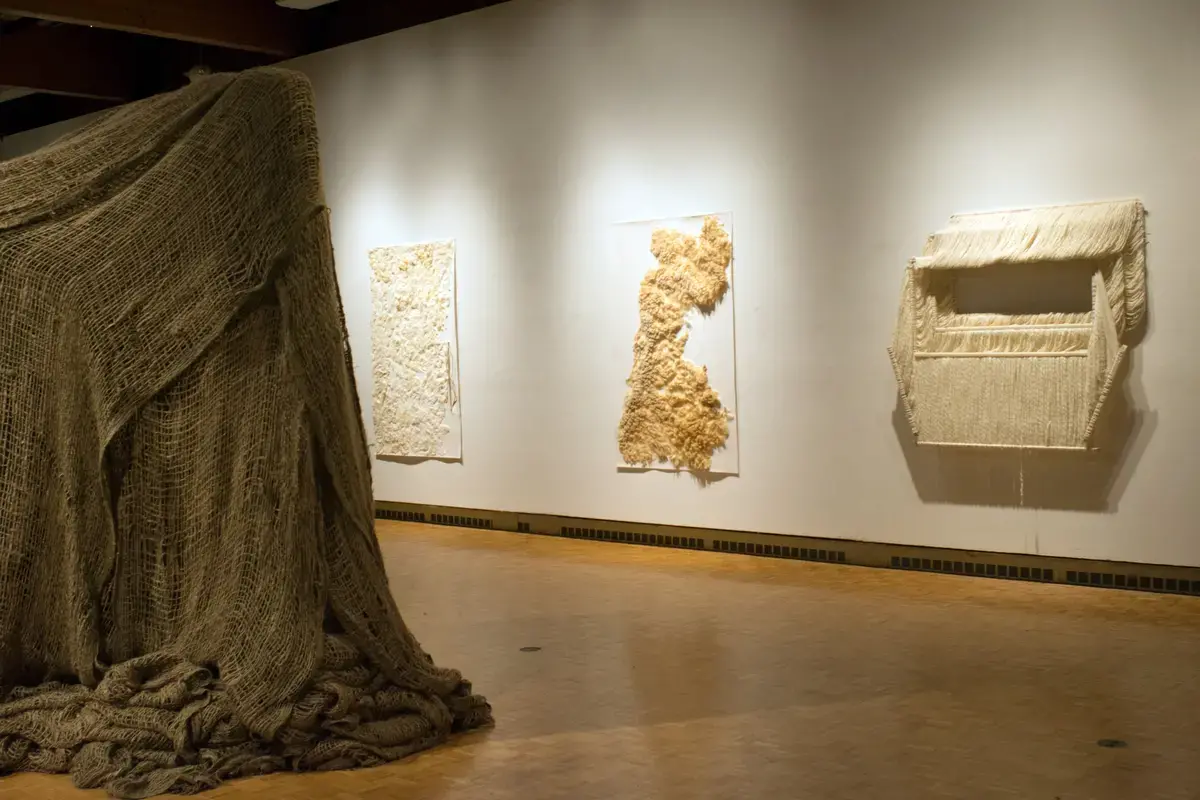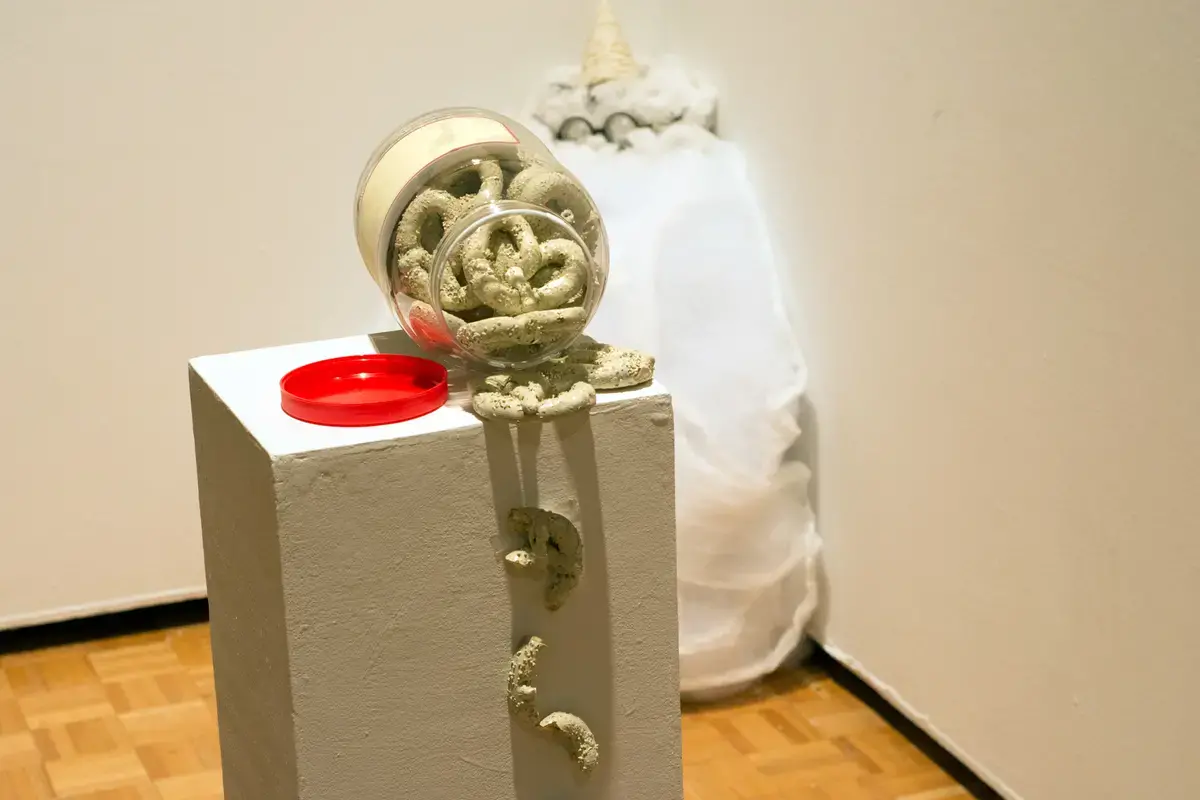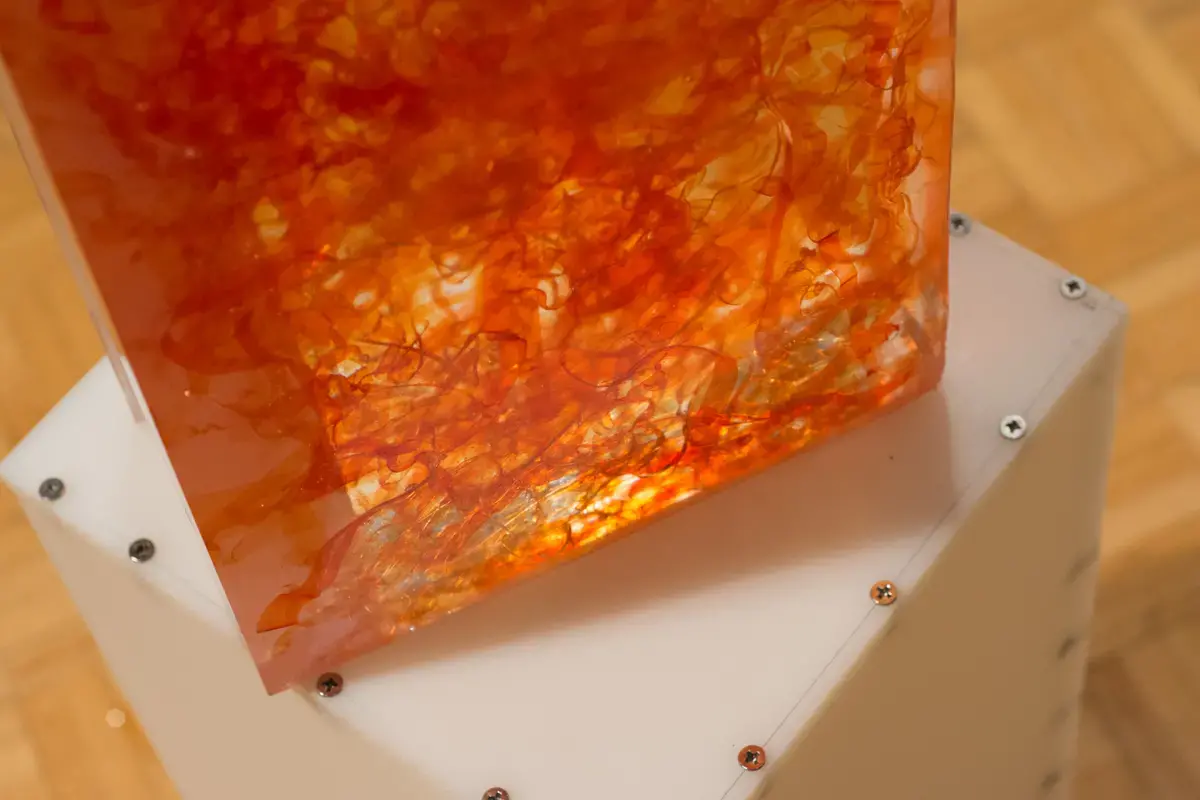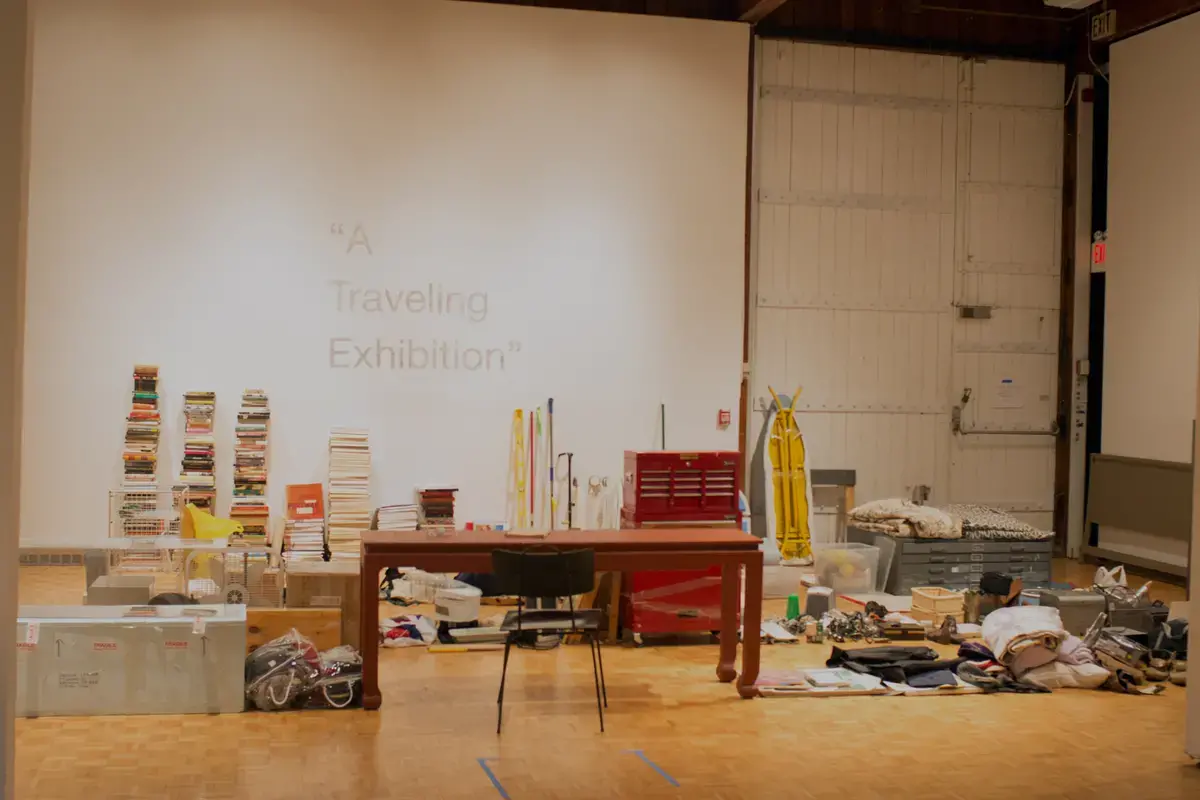Young Alumni Artists in Residence

Ariel Herwitz ’06, Floryn Honnet ’13, Rainer Hunt ’13, and Georgia Lassner ’09 are the inaugural class of a new residency for young alumni artists that was established at Bennington this year. Funded by a grant from an anonymous donor made in honor of faculty members Barry Bartlett and Jon Isherwood, the program invites recent graduates in sculpture and ceramics to live and work on campus for two- to four-week stints. In “studios” in Usdan Gallery, these four artists have had a chance to dive into their practice mostly uninterrupted, and current students have had the opportunity to interact with them in a variety of ways. Says Jon Isherwood, one of the designers of the residency, “It’s a very exciting moment for us in the Visual Arts to be able to bring back alumni and have them develop new work in the gallery. The premise of the residency has been to encourage experimentation. Complimenting this, the VA faculty have invited our alumni guests to visit classes and meet with students one on one.”
The fruits of the artists’ labors will be on view at Usdan Gallery from November 29 through December 8. They spoke with Aruna D’Souza about their student experiences, their approach to art making, and their experience being back on campus.

Ariel Herwitz '06: How to Be an Artist
After graduating from Bennington in 2006, having studied ceramics, psychology, and dance, Ariel Herwitz ‘06 moved to Chicago with another recent graduate, Shira Sternberg '05, to work at a ceramics studio, trying to make ends meet on $800 a month and making as much work as she could while also teaching children's wheel throwing classes. Her next gig was an office job at Harvard’s Graduate School of Design, building her ceramics portfolio while taking art history classes on the side, and then after that she pursued an MFA at Cranbrook Academy of Art. It was only after her move to Los Angeles that her work shifted primarily in the direction of fiber arts—partly as a matter of practicality, since she no longer had the facilities like the ones offered by Bennington at her disposal, and partly because it allowed her to assume a kind of improvisational logic that she’d first developed in her dance classes. After showing in a number of group shows and developing her practice, she eventually quit her job as an artist’s assistant and began devoting herself full-time to her own studio work; her first solo exhibition at Ochi Projects took place this fall.
Ariel has spent a lot of time recounting this story to the students who wander past Usdan Gallery, which is serving as studio space for the four artists taking part in the Young Alumni Artists Residency this year. The exposed nature of their work site is by design—the idea of the residency was to offer graduated artists the chance to take some time to focus on their own work, but also a chance for students to learn from the artists in both formal (talks, studio crits) and informal (chance encounters in Usdan) ways.
Most of the students who have dropped by Ariel’s workspace have wanted to find out two things: first, how she makes her fibre works—wall-mounted felted pieces using fluffy bits of raw wool, stacked frames wrapped with wool string, and a monumental structure in the middle of the gallery draped with irregularly woven jute that puddles on the ground and has the presence of a mastodon—and second, how she’s managed, in the space of ten short years, to become a full-time practicing artist.
Ariel is happy to oblige. “There’s no one here to teach you how to actually go out into the world and just be an artist. So, I've tried to be that person while I'm here. And of course, the first thing I tell anyone who asks is that this is what worked for me, that everyone will find a different path and see what works for them. But I guess that’s what’s great about a Bennington education—you have to figure out how to do it on your own, no one is going to lay out the procedure for you. You just have to find your way; you have to shift and move and create your own path. That pretty much describes how I've approached my life after Bennington.”

Floryn Honnet ’13: Like Gas in a Bottle
For Floryn Honnet ’13, the Young Alumni Artists Residency was a chance to figure out how to set up an art practice that wasn’t driven by class projects, organized critiques, or academic schedules, as it had been while she was a student at Bennington. The experience was invaluable, she says. “It was an opportunity to take risks and make work outside of any external pressure to make something quote-unquote final.”
With the space, resources, and time to dive back into studio practice, Floryn pulled out all the stops, mining her trove of found objects and unusual materials she’d been accumulating over the years and rediscovering her long-standing interest in cartoon aesthetics. During a cross-country drive just before the start of the residency, she began, almost unconsciously, to look at the landscape as a source of new ideas. But it was only when she got into her studio-slash-exhibition space in Usdan Gallery that she decided what to make—the possibilities offered by the high ceilings, the windows and skylight, the moveable walls all played a part in her thought process.
The largest piece in the gallery is composed of 20-foot pine boards she found remaindered at the local Home Depot because they were not straight enough to use for building; she covered the real wood—real, but already having been subjected to industrial manufacturing processes— in wood-grain contact paper, applied clumps of expanding foam, puff paint, and plastic dollar store leaves, and leaned them against the wall. The careful lighting cast shadows that turned this array of lumber into a witty forest that complicates the line between natural and unnatural, something out of a minimalist set for a Bugs Bunny cartoon.
Other pieces in the gallery mined this same fascination with kitsch, dime-store materials, and whimsy. A contraption of disembodied hands almost touching was a clear reference to Michelangelo's Creation of Adam. Spills of spray-painted pretzels and rigatoni and a bucket of plaster mixed with oatmeal turn food into inedible reflections on value. Many of her pieces refer to domesticity and “women’s work,” tying commodity fetishism, gender, and care into a complicated knot.
As for where to go from here, Floryn has ideas. She’ll use the work she made as part of her residency as the basis of a portfolio to apply for other residencies so that she continues to have the opportunity to make art. But she will also find ways to work it into the realities of her daily life. “Art practice is like gas in a bottle,” she says. “It expands or contracts to fit the space.”

Rainer Hunt ’13: DIY to Collaboration
After Rainer Hunt ’13 graduated, she put her Field Work Term experience to good use by going to work at one of the commercial film companies she had interned at, and quickly began building a career in New York City as the assistant to a director. Figuring out how to fit artmaking back into her schedule was a challenge, given limitations of time and space.
But thanks to the gentle but persistent encouragement of Jon Isherwood, who was one of her advisors at Bennington and continued to mentor her after she graduated, she began to think about what sort of work she could do given these constraints. Inspired by a gift she received from a fellow student in her senior year—a small memento from her classmate Amira Hankin ‘13 consisting of a small bit of studio detritus (a scrap of lighting gel, one of Rainer’s favorite materials) encased in a small amulet, she began making objects again.
Using the lighting gels that were discarded after commercial shoots at her workplace and molds that her brother, a student at Cooper Union, helped her fashion, along with information that she gleaned from doing online research, talking to manufacturers, and YouTube videos, Rainer started experimenting. In the evenings after work, she would arrange the lighting gels in the mold and pour thin (⅛”) layers of resin, waiting for each layer to dry before adding another, until she had large blocks. She was using a non-toxic form of the material, but admits with a laugh that she probably should have been using a gas mask in her small kitchen.
The invitation to take part in the first Young Alumni Artists Residency came at exactly the right moment for her, allowing her to transform her DIY efforts by working alongside technical experts and using the advanced technologies and tools available to her at Bennington.
It was a conversation with Isherwood that allowed Rainer to develop her simple prototypes—blocks of resin in which intensely colored strips of gel float and dance in three dimensions, as if frozen in space—into more complex shapes. He pointed her in the direction of Michael Stradley, the College’s 3D technician and a specialist in digital design, and the three-axis CNC mill—a digital tool that uses programmed information to make precise cuts into sculptural materials—and as a result of this collaboration, she began etching on the surface of the blocks to mimic the spontaneous, complex curves of the gel strips within, or making intricate slices across corners and edges. When she discovered that the resin she was using was reacting differently in the Vermont cold compared to the heat of her New York apartment, getting cloudy and trapping bubbles, John Umphlett MFA ’99, an interdisciplinary technician with an expertise in materials, hooked her up with an auto body shop in Shaftsbury who helped her solve that problem.
“When it came to making the cuts and dealing with the materials, I didn’t know the full range of possibilities until I got here and started talking to people,” she says.
Working alongside other alumni artists at very different stages in their careers was also inspiring for Rainer, both in terms of sharing ideas and dealing with the day to day formal and technical problems she was tackling in the studio as well as in giving her ideas about how to organize her practice after she leaves the residency. “For me, the residency gave me the motivation, drive, and dedication to continue my art making. I have to make it a daily habit. Rather than watching TV or reading after work, I can get to work.”

Georgia Lassner ’09: A Traveling Exhibition
Georgia Lassner ’09 recalls a course she took in her senior year at Bennington: students were asked by faculty member Yoko Inoue to design a site specific work. Georgia imagined an installation that would work in dialogue with the collection of the Bennington Museum; when she talked to Inoue about it, her teacher’s response was encouraging. “Now you should go to the Bennington Museum and tell them you’d like to exhibit the work there!”
Georgia left the meeting and started preparing a presentation for the curator at the Bennington Museum, blithely unaware that receiving a solo show at the regional museum while still a student was something of a long shot, to say the least. Presented with her proposal, diagrams, and drawings, the Bennington Museum agreed to show the work for 24 hours. When she reported back to Inoue that the museum said yes, Inoue was floored: “I didn’t think you’d actually do it!”
Georgia’s career post-Bennington has similarly involved taking the bull by the horns, so to speak. After working for some time in a tiny and (she says) awful studio in Williamsburg, Brooklyn, she went to work at an architectural firm, happy to be around creative people all day. Her wife, Sarah, a curator, encouraged her to pursue her MFA. She ended up pursuing her degree at CalArts, one of the premier art schools in the country. She now lives and works in Los Angeles.
Coming back to Bennington for the residency was both an opportunity and, as Georgia describes it, a chance to reflect on her time here and the responsibilities she felt towards the institution, her education, and the students. “There’s a lot of pressure involved in making a work over the course of the residency—you want it to represent you, please the people who invited you, say something to the students who are studying here now. There’s a lot of pressure you put on yourself to make it ‘great.’”
Faced with these pressures, and cognizant of the fact that she was back on the east coast, far from her new home, she decided to make a work that, as she describes it, is “as boring as possible”—but one that thematized the logistics of moving between sites. She flew to New York, rented a U-Haul, loaded up the contents of her storage locker—the remnants of her life in Brooklyn—and drove it up to Bennington, where she has unpacked it in the gallery with the title “A Traveling Exhibition.” Books, magazines, a file cabinet, tools, household objects of all sorts, a glass vitrine, a table—all these and more are arranged in neat-ish rows in the space, with seemingly little logic to their arrangement other than the order in which they were unpacked. At the end of the show, they’ll be loaded back into the container and shipped out to Los Angeles—where they will be unpacked again.
For Georgia, the work is a way of introducing students at Bennington to ideas that they may not be thinking about in their more object-oriented practices: questions of the logistics of moving and showing work, for example, of archives, of curating. There is a challenge, too, of not doing anything to the accumulated goods, of being okay with leaving them unchanged. “It’s not generally how a residency works,” she says. “Normally you arrive, you settle into your studio, and you make something. But with this, the storage container arrived the first day, I unpacked it, and instead of ‘making’ something in my studio, so to speak, I’m spending the time just being with the objects, and trying to understand what this gesture means. That’s really important.”
Future Directions
For Barry Bartlett and Jon Isherwood, this pilot project was a great success; based on feedback from the group, they will offer a second residency in 2017-18 and in future years, depending on funding opportunities. Says Isherwood: “Students and faculty told us how significant this first exploration into re-engaging alumni was for them. Barry and I were deeply moved by the generosity that allowed us to launch this first residency, and hope this endeavor reflects our gratitude and our teaching philosophies.”